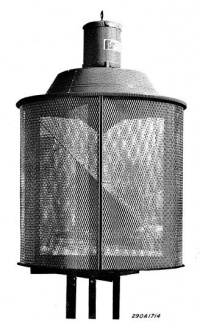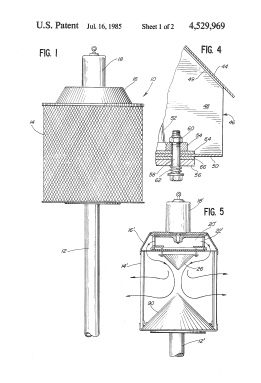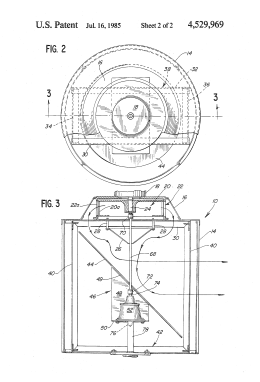Thunderbeam: Difference between revisions
(Added some history to the Thunderbeam. Sources include: US patent, obituary for Earl Gosswiller, etc. etc.) |
TheCamWheel (talk | contribs) mNo edit summary |
||
| (9 intermediate revisions by 3 users not shown) | |||
| Line 1: | Line 1: | ||
{{Infobox siren | {{Infobox siren|image=RSH-10 Official.jpg|company=[[Federal Signal Corporation]]|produced=1983-1995|type=Hybrid [[Rotational]]/[[Omnidirectional]] [[Electromechanical]]|output=120-124 dB @ 100 ft|hp=10 hp|voltage=208-240/480|manual=https://www.davidsonhosted.com/sireninfo/sirenmanuals/Federal%20Signal%20Manuals/Thunderbeam%20%28RSH-10%29%20Installation%20and%20Operation%20Manual.pdf|hertz=50/60|title=Federal Signal RSH-10 "Thunderbeam"|preceded=[[Federal Signal 500]]<div>[[Federal Signal Thunderbolt]] | ||
|image= | |succeeded=[[Federal Signal 2001]]}}The '''RSH-10 "Thunderbeam"''' is a unique rotational/omnidirectional hybrid siren that was produced by [[:Category:Federal Signal Corporation|Federal Signal Corporation]] for over a decade, replacing the earlier [[Federal Signal 500|500-SH]]. The Thunderbeam was a popular siren, and its design allowed it to be much louder than its omnidirectional cousins. RSH-10 stands for "Rotating Single-tone High, 10 Horsepower". | ||
|company= [[Federal Signal Corporation]] | |||
| | |||
|type= [[ | |||
|manual= https://www. | |||
}} | |||
The RSH-10, | == History and design == | ||
The RSH-10, advertised as the "Thunderbeam", was designed and created by Federal's then-chief designer, Earl Gosswiller in 1982. The siren was patented the same year, with the patent being published in 1985. The Thunderbeam would be Gosswiller's last patent, as he would retire from Federal in 1982. The siren was made in an attempt to amplify the sound of an omnidirectional siren without the need for an entire rotator assembly or horns. | |||
The | The RSH-10 makes use of a very unique design. Rather than having the rotor and stator inside of a horn that rotates, the RSH-10 instead has a stationary rotor and stator with a separate rotating deflector. The RSH-10 makes use of Federal's [[Federal Signal STH-10|STH-10]]'s rotor and stator, but instead of using horns to project the sound, the sound is instead directed downwards, and this concentrated beam of sound is then deflected by a rotating disc deflector, which is driven at 2 rpm by a 1592:1 gear reduction drive on the bottom of the disc directly attached to the rotor using a long shaft. This greatly amplifies and projects the sound, allowing it to reach 124 dB at 100 ft, far more than the 115 dB of a standard STH-10. Federal Signal originally claimed the siren to reach 128 dB, but later reduced it to 124 dB. | ||
[[File:US4529969-1.png|thumb|Patent for the Thunderbeam.]] | Because the disc is directly driven by the rotor, the disc rotates and coasts with the rotor like an [[Alerting Communicators of America|ACA]] [[ACA Penetrator|Penetrator]] siren. The gearbox underneath the disc requires regular maintenance and lubrication. An unmaintained gearbox has the risk of stripping the gears during operation, causing the disc to spin incredibly fast which may lead to further damage to the siren. The disc is enclosed inside a very large metal mesh cage, which protects it from the elements. The rotor and stator are housed inside of a cover which is shaped in a way to direct the sound downwards, while also preventing rain and debris from damaging the rotor and stator. The siren's bare 10 hp electric motor is located on top of this cover, and was available in 1 and 3 ph, the RSH-10B and RSH-10A respectively. | ||
[[File:US4529969-2.png|thumb|Other part of the patent. The full version includes a description as well of the siren.]] | |||
Federal experimented with an RSL-10 during the siren's early development, using the rotor and stator from the 7-port [[Federal Signal STL-10|STL-10]]. These used flattened horns that directed the sound down towards the disc, and the same concept was used with prototypical RSH-10 as well. Federal decided to drop the RSL-10 concept for unknown reasons, and they dropped the idea of using flattened horns in favor of a deflector to save costs, despite the reduced performance from doing so. No RSL-10 units are known to exist today.[[File:US4529969-1.png|thumb|Patent for the Thunderbeam.|384x384px]]The RSH-10 was a versatile multipurpose siren and was able to be used as a civil defense siren, a fire siren, or a severe weather siren. It was fairly popular, as it didn't cost much more than an STH-10 while offering superior performance. The RSH-10 would be discontinued around 1995, as this was the last time the Thunderbeam would be advertised or featured in any Federal publication. Today, the [[Federal Signal Model ECLIPSE|ECLIPSE<sup>8</sup>]] takes its role as Federal Signal's main electromechanical omnidirectional siren. Many examples of RSH-10 sirens can still be found in service today across the United States, due to their popularity and ease of maintenance. [[File:US4529969-2.png|thumb|Other part of the patent. The full version includes a description as well of the siren.|382x382px]] | |||
[[Category:Rotating Sirens]] [[Category:Electromechanical Sirens]] [[Category:Federal Signal Corporation]][[Category:Single Toned Sirens]][[Category:Sirens]] | [[Category:Rotating Sirens]] [[Category:Electromechanical Sirens]] [[Category:Federal Signal Corporation]][[Category:Single Toned Sirens]][[Category:Sirens]] | ||
Revision as of 17:16, 15 September 2024
| Federal Signal RSH-10 "Thunderbeam" | |

| |
| Company | Federal Signal Corporation |
|---|---|
| Produced | 1983-1995 |
| Type | Hybrid Rotational/Omnidirectional Electromechanical |
| Sound output | 120-124 dB @ 100 ft |
| Horsepower | 10 hp |
| Voltage | 208-240/480 V |
| Preceded by | Federal Signal 500 |
| Succeeded by | Federal Signal 2001 |
| Documentation | Manual |
The RSH-10 "Thunderbeam" is a unique rotational/omnidirectional hybrid siren that was produced by Federal Signal Corporation for over a decade, replacing the earlier 500-SH. The Thunderbeam was a popular siren, and its design allowed it to be much louder than its omnidirectional cousins. RSH-10 stands for "Rotating Single-tone High, 10 Horsepower".
History and design
The RSH-10, advertised as the "Thunderbeam", was designed and created by Federal's then-chief designer, Earl Gosswiller in 1982. The siren was patented the same year, with the patent being published in 1985. The Thunderbeam would be Gosswiller's last patent, as he would retire from Federal in 1982. The siren was made in an attempt to amplify the sound of an omnidirectional siren without the need for an entire rotator assembly or horns.
The RSH-10 makes use of a very unique design. Rather than having the rotor and stator inside of a horn that rotates, the RSH-10 instead has a stationary rotor and stator with a separate rotating deflector. The RSH-10 makes use of Federal's STH-10's rotor and stator, but instead of using horns to project the sound, the sound is instead directed downwards, and this concentrated beam of sound is then deflected by a rotating disc deflector, which is driven at 2 rpm by a 1592:1 gear reduction drive on the bottom of the disc directly attached to the rotor using a long shaft. This greatly amplifies and projects the sound, allowing it to reach 124 dB at 100 ft, far more than the 115 dB of a standard STH-10. Federal Signal originally claimed the siren to reach 128 dB, but later reduced it to 124 dB.
Because the disc is directly driven by the rotor, the disc rotates and coasts with the rotor like an ACA Penetrator siren. The gearbox underneath the disc requires regular maintenance and lubrication. An unmaintained gearbox has the risk of stripping the gears during operation, causing the disc to spin incredibly fast which may lead to further damage to the siren. The disc is enclosed inside a very large metal mesh cage, which protects it from the elements. The rotor and stator are housed inside of a cover which is shaped in a way to direct the sound downwards, while also preventing rain and debris from damaging the rotor and stator. The siren's bare 10 hp electric motor is located on top of this cover, and was available in 1 and 3 ph, the RSH-10B and RSH-10A respectively.
Federal experimented with an RSL-10 during the siren's early development, using the rotor and stator from the 7-port STL-10. These used flattened horns that directed the sound down towards the disc, and the same concept was used with prototypical RSH-10 as well. Federal decided to drop the RSL-10 concept for unknown reasons, and they dropped the idea of using flattened horns in favor of a deflector to save costs, despite the reduced performance from doing so. No RSL-10 units are known to exist today.

The RSH-10 was a versatile multipurpose siren and was able to be used as a civil defense siren, a fire siren, or a severe weather siren. It was fairly popular, as it didn't cost much more than an STH-10 while offering superior performance. The RSH-10 would be discontinued around 1995, as this was the last time the Thunderbeam would be advertised or featured in any Federal publication. Today, the ECLIPSE8 takes its role as Federal Signal's main electromechanical omnidirectional siren. Many examples of RSH-10 sirens can still be found in service today across the United States, due to their popularity and ease of maintenance.
